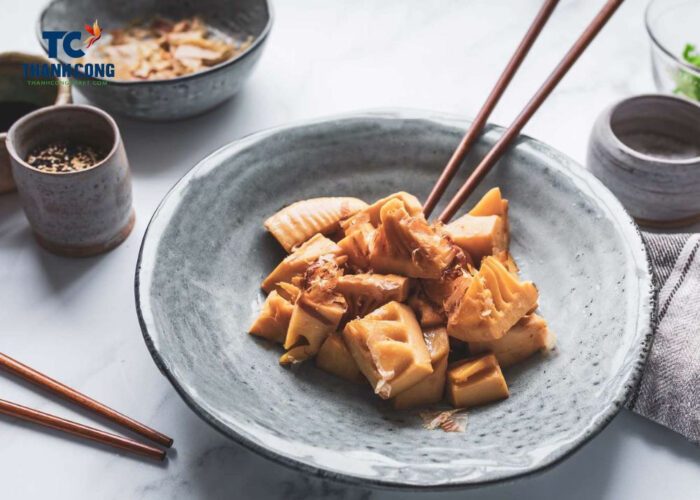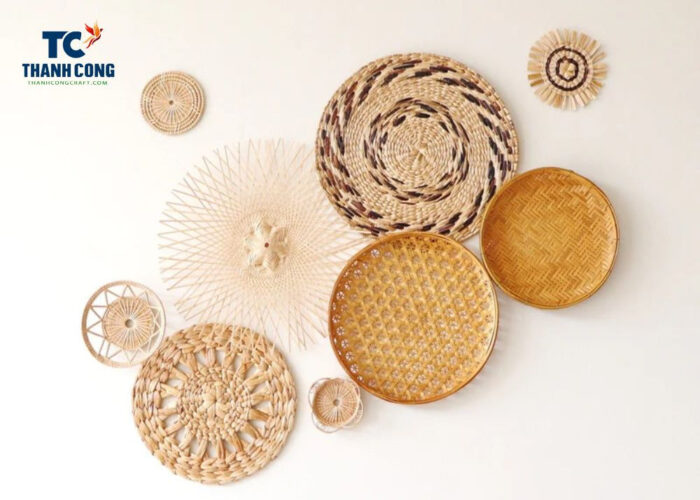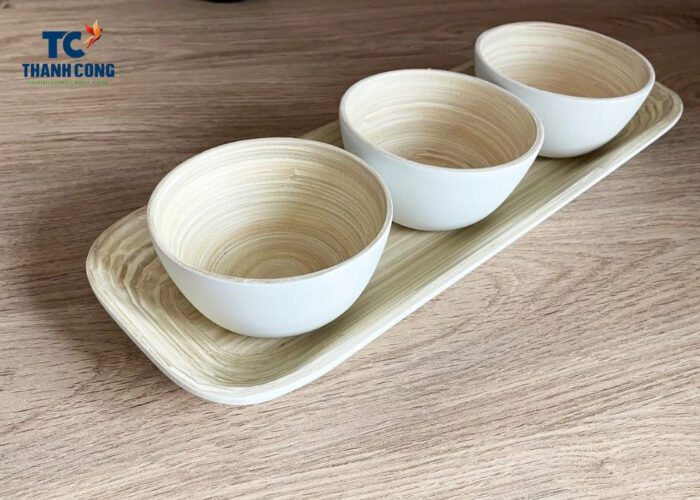Recognized for its environmentally friendly attributes, bamboo has gained widespread popularity in various industries. Curious about its versatility? Discover 5 uses of bamboo that might surprise you. Dive into the article below to delve deeper into this remarkable material!
Contents
1. Food from bamboo
Undoubtedly, bamboo holds a pivotal place in a wide range of global culinary practices. Notably, its youthful shoots are deemed delicacies across several Asian cuisines. Apart from their nutritional value, these tender shoots contribute unique flavors and textures to dishes.

Furthermore, bamboo’s role extends to culinary containers. Bamboo steamers are an essential tool in Asian cuisine, facilitating gentle cooking that preserves flavors and nutrients. Additionally, bamboo leaves frequently double as both wrappers and cooking vessels, imparting a delicate earthy essence to foods.
2. In the realm of construction
Bamboo stands as a testament to the ingenuity of early builders, predating the use of concrete and steel. With its robust trunk and flexible nature, bamboo has been employed in crafting enduring houses that have stood the test of time.
The split bamboo shingles, when intricately arranged, yield walls of both remarkable strength and visual appeal. Even today, bamboo maintains its popularity as a construction material, serving diverse purposes. It reinforces foundations and remains a preferred choice for structural support. Furthermore, in the context of irrigation projects, bamboo is instrumental in fortifying dikes, dams, and other essential infrastructure, showcasing its lasting relevance in engineering endeavors.
3. Bamboo’s Role in Cultural Arts: From Writing and Music to Martial Arts
Bamboo’s versatility extends beyond its practical applications; it has a profound influence on various aspects of cultural arts, enriching traditions and practices across the globe. From the tranquil world of calligraphy to the rhythmic melodies of music, and even the disciplined arena of martial arts, bamboo’s role in cultural arts is a testament to its enduring significance.
- In many cultures, bamboo is transformed into writing instruments such as brushes and pens. The unique texture and flexibility of bamboo allow for intricate strokes in calligraphy. Artists and writers appreciate the natural connection between the material and their creative expressions.
- Bamboo’s resonance and tonal qualities make it an excellent choice for crafting musical instruments. Flutes, wind instruments, and even percussion instruments like xylophones and drums are often made from bamboo. The melodious tunes that emanate from these instruments reflect bamboo’s harmonious integration into the world of music.

- Bamboo’s strength and flexibility lend themselves to the creation of weapons and training tools in various martial arts disciplines. Bamboo staffs, swords, and training dummies are commonly used in practices like kendo, escrima, and more. The material’s balance of durability and responsiveness contributes to the mastery of martial skills.
- Bamboo’s natural aesthetic lends itself to the creation of sculptures and art installations. Artists around the world utilize bamboo’s form and texture to bring their visions to life, from intricate sculptures to large-scale installations that captivate audiences.
4. Elevate Your Home Decor with Bamboo Elegance
- Woven Bamboo Dining Sets: Elevate your dining space with the elegance of woven bamboo dining tables and chairs. Infuse your environment with an invigorating, inventive, and sophisticated atmosphere.
- Bamboo Lamp Shades: Embrace the rustic allure of woven bamboo lamps to cultivate a snug, contemporary, and refined ambiance, radiating both warmth and character.
- Bamboo cabinets: The natural grains and textures of bamboo give cabinets a distinct and visually pleasing appearance. From modern minimalist designs to rustic and traditional styles, bamboo cabinets cater to diverse interior design preferences.
- Bamboo cabinets are relatively easy to maintain. They are less prone to warping or cracking and can be kept in good condition with regular cleaning and minimal upkeep.
- Plate Wall Hangin Decor: Decorative bamboo plates for wall hanging will bring you the perfect asmosphere in your room. Whether you are in your Dining Room, Kitchen, or Picnic, the portable wall decor plates will tag along for every action. These natural handmade plates are uniquely woven, each has its own differences. Bamboo plate hangers for wall are relatively lightweight compared to other materials like ceramic or glass. This makes them easier to hang on the wall without the need for heavy-duty hooks or brackets.

- Bamboo Dividers, Curtains, and Mats: Beyond their visual appeal, woven bamboo serves as functional dividers, curtains, or floor mats, endowing your living space with both natural charm and practicality.
- Bamboo Plant Containers: Potted plants and flowers cultivated in containers crafted from bamboo and wood are a rising trend. Bamboo containers radiate nature’s beauty and sophistication, becoming a focal point on balconies, doorways, offices, apartments, and gardens. Enjoy the pleasures of tending to your greens with minimal care and watering, all while embracing the tranquility of nature in your abode.
5. Dining Experience with Bamboo Utensils and Tableware
In the realm of culinary indulgence, bamboo emerges as a unique and sustainable material for crafting utensils and tableware. Its innate elegance and eco-friendly attributes make it a popular choice for those seeking to harmonize functionality with aesthetics, and to reduce their environmental footprint.
- Bamboo Cutlery Sets: Elevate your dining rituals with bamboo cutlery sets. Lightweight, yet durable, these utensils offer a natural touch to your table while minimizing the use of plastic alternatives.
- Bamboo Plates and Bamboo Bowls: Embrace the charm of bamboo plates and bowls, adding an organic elegance to your table settings. These pieces are not only visually appealing but also environmentally responsible.

- Bamboo Drinkware: Sip in style with bamboo drinkware. From bamboo tumblers to cups, their unique textures and eco-conscious design enhance your beverage experience.
- Bamboo Serving Trays: Serve your delectable creations with flair using bamboo serving trays. These trays combine functionality and aesthetics, making your meals a visual delight.
- Bamboo Coasters and Napkin Rings: Elevate your table decor with bamboo coasters and napkin rings. Their natural textures add a touch of sophistication to your dining settings.
The integration of bamboo into utensils and tableware exemplifies the fusion of practicality, aesthetics, and sustainability. With each meal, you contribute to a greener lifestyle, all while savoring the beauty and charm that bamboo imparts to your dining moments.
6. Bamboo Uses FAQ
6.1. What is the most useful feature of bamboo?
One of the most useful features of bamboo is its fast growth rate, which makes it a renewable and eco-friendly resource. Bamboo also has a high strength-to-weight ratio, which makes it suitable for building materials, furniture, flooring, and other products. Bamboo can also be processed into fibers, fabrics, paper, charcoal, and biofuel, among other things. Bamboo is not only useful, but also beautiful and elegant, adding aesthetic value to any space or product.
6.2. What is bamboo used for in the construction industry?
Bamboo is a natural composite material utilized as a building material for various purposes. Some of the applications of bamboo include scaffolding, bridges, houses, flooring, walls, ceilings, decking, cladding and furniture.
6.3. What kind of housing is bamboo useful for?
Bamboo is a versatile and sustainable material that can be used for various types of housing. Bamboo can be used to build low-cost and eco-friendly houses for rural communities, as well as modern and innovative structures for urban areas.
Bamboo can also be combined with other materials, such as concrete, steel, or wood, to create hybrid designs that enhance the performance and aesthetics of the buildings. Bamboo is therefore a useful material for housing that can meet different needs and preferences.
Above is 5 Uses Of Bamboo You Already Know? If you have any further questions, please don’t hesitate to contact Thanh Cong Craft email at info@thanhcongcraft.com or message us at WhatsApp: +84967485411. Hope to serve you soon! Best regard!












